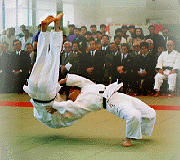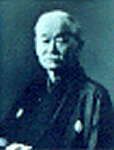|
|
From the twelfth to the nineteenth century Japan was ruled by the samurai, a class of professional soldiers. This provided fertile ground for various martial arts to develop. In addition to fighting with swords and bows and arrows, the samurai developed jujitsu to fight enemies at close quarters on the battlefield. Several different styles of jujitsu evolved, and hand-to-hand combat spread as an important form of military training.

Kano went to Europe in 1889 to introduce judo outside of Japan. A famous episode occurred aboard a ship during his voyage: When a foreigner made fun of Kano, he threw the man down but put his hand under the man's head to prevent him from getting hurt. This illustrated how judo combined practical fighting techniques with thoughtfulness for one's enemy. Kano always maintained a global point of view, serving as a member of the International Olympic Committee, and worked tirelessly to spread judo around the world. Kano's dream came true at the Tokyo Olympics in 1964, where men's judo was recognized as an official Olympic event. Medals were awarded to competitors in various weight divisions, and Japanese competitors swept the gold in all except the open division, where a non-Japanese champion was crowned. This was a sign that judo had already taken root in countries outside Japan. Women's judo was introduced as a demonstration event at the 1988 Seoul Olympics and was added to the official program at the Barcelona Olympics in 1992. Currently some 184 countries and regions are members of the International Judo Federation. The sport is particularly popular in Europe. In fact, many more people in France practice judo than in Japan. Japan is continuing to promote judo in other countries, such as by sending instructors to regions where judo is not so well known--like Africa and Oceania--and donating secondhand judo uniforms. |
|
Photos: (from top) A judo demonstration; Jigoro Kano; The Kodokan Judo Institute just after it was built. (Kodokan Judo Institute) |
 Judo is a martial art that was born in Japan, and it is now known around
the world as an Olympic sport. Judo was established in 1882 by combining
jujitsu, a form of wrestling, with mental discipline. The roots of jujitsu
lie in
Judo is a martial art that was born in Japan, and it is now known around
the world as an Olympic sport. Judo was established in 1882 by combining
jujitsu, a form of wrestling, with mental discipline. The roots of jujitsu
lie in  The era of samurai rule came to an end with the Meiji Restoration
of 1868, and Western culture began filtering in into Japanese society.
The era of samurai rule came to an end with the Meiji Restoration
of 1868, and Western culture began filtering in into Japanese society.